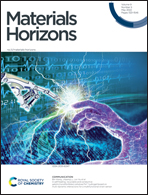Giant tunnelling electroresistance through 2D sliding ferroelectric materials†
Abstract
Very recently, ferroelectric polarization in staggered bilayer hexagonal boron nitride (BBN) and its novel sliding inversion mechanism were reported experimentally (Science2021, 372, 1458; 2021, 372, 1462), which paved a new way to realizing van der Waals (vdW) ferroelectric devices with new functionalities. Here, we develop vdW sliding ferroelectric tunnel junctions (FTJs) using the sliding ferroelectric BBN unit as an ultrathin barrier and explore their transport properties with different ferroelectric states and metal contacts via first principles. It is found that the electrode/BBN contact electric field quenches the ferroelectricity in the staggered BBN, resulting in a very small tunnelling electroresistance (TER). Inserting high-mobility 2D materials between Au and BN can restore the BBN ferroelectricity, reaching a giant TER of ∼10 000% in sliding FTJs. We finally investigate the metal-contact and thickness effect on the tunnelling property of sliding FTJs. The giant TER and multiple non-volatile resistance states in vdW sliding FTJs show promising applications in voltage-controlled nano-memories with ultrahigh storage density.



 Please wait while we load your content...
Please wait while we load your content...